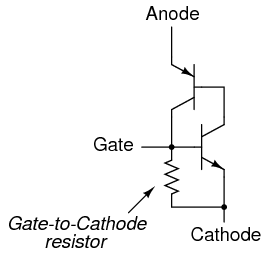Sir chet . . . . . .
I was busy transferring the resistor values from your schema to the other one that I had found and was then just basically consulting his schema on that made observation.
Its common design fare to use either a digital stream or a simpler single unijunction transistor to drive a SCR 's gate.
Since unijunctions are becoming in less favor after a 50 year design / use period. Prices are going up on them.greatly.
It is possible to cheaply replicate them with a single cheeeeep NPN and PNP transistor pair.
Your made up schema is providing better referencing to the left of the schema, so I now refer to your copy and see that actually, no " simulated " unijunction transistor function was being replicated by the use of a cross coupled NPN and PNP transistor.
I do see a variant of the Sziklai pair being used with N1 and P4 transistors.
That pair is being used to get a high gain of a voltage sampled at the output of the 431 programmable zener diode reference, over to the base of N3 which is being used to variably trim in the drive level being fed into the gate of the SCR.
Since you did not mention if you had initially tested all of the transistors for having good C to B and B to C junctions, lets now try some tests on your fully wired up unit.
You said that your hook up to your car battery gave a quite short charge time before the activation of the GREEN LED.
You can avert that by either the turning on and leaving of the headlights on HIGH beam and the activation of the fresh air moving car ventilation system in HIGH motor / fan position.
Leave them on for a time period to drag down your battery charge state a bit, or also leave them on during testing.
We just want to be able to see that ammeter pointer . . . being between scale limits . . . and see the charge current variances.
Take a double clip ended test wire and one clip lead end goes to the base of N3 and then you observe the charge ammeter reading and place the free clip end lead to any of the common ground buss points at the bottom of the schematic.
Which direction did the ammeter pointer then swing, and if any effect on the GREEN LED intensity . . .if being on ?
Move the double clip ended test wire and have one clip lead end to the base of P1 and make the same initial observation of the ammeter and then the same grounding of the free clip.
Here, we are also equally interested in the ammeters pointer direction .
My final interim info here, is for your query of:
Do you know what the "shopstop" on the schematic refers to?
That is the definition that he self assigned to the auto reset/overload circuit breaker which you correctly show on your schematic.
Its likely to pop . . .and very s.l.o.w.l.y. cycle, if you happen to use the high current START mode for too long.
Thasssssit
FOR TECHNO REFERENCING:
73 ' s de Edd






